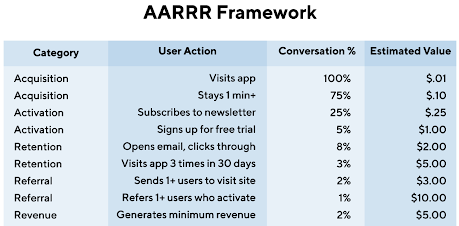\ AARRR Methodology and how to use it
What are AARRR Metrics?
AARRR Pirate Metrics framework is an acronym for a set of five user-behavior metrics that product-led growth businesses should be tracking: acquisition, activation, retention, referral, and revenue.
Acquisition (or awareness) – How are people discovering our product or company?
Activation – Are these people taking the actions we want them to?
Retention – Are our activated users continuing to engage with the product?
Referral – Do users like the product enough to tell others about it?
Revenue – Are our personas willing to pay for this product?)
Who created AARRR and Why?
A Silicon Valley investor called Dave McClure developed the AARRR framework. McClure saw that many startup companies were easily distracted by superficial (some call them vanity) metrics, such as likes on social media.
With AARRR, McClure had a twofold goal. First, show how startups could narrow their focus to only those metrics that can directly affect the health of their overall business. But second, to help these companies use the right data to build and understand the success of their product management and marketing efforts, then improve those initiatives that aren’t working.
Here is a summarised version of McClure’s own sample AARRR metrics chart.


You’ve got growth goals? We’ll build the roadmap.
Businesses need a data-driven vision. More importantly, they need a clear, action-packed game plan. We partner with you to strategize, prioritize, link up cross-channel insights, and, ultimately, grow.
How Does the AARRR Pirate Metrics Framework Work?
Step 1: Identify your AARRR Pirate Metrics.
Your first step is to identify conversion metrics for each of these five user behaviours. Here are a few examples of each:
Acquisition Metrics:
In the AARRR framework, acquisition refers to all of the channels you use to introduce people to your product. This could include:
» SEO
» Social media
» Marketing campaigns
» Apps and widgets
» Advertising
Activation Metrics:
The activation element refers to users taking the desired actions, or next steps, after their first encounter with your company’s product, website, or content. For example:
» Visiting next pages for further information
» Trying out additional features of your product
» Spending a given amount of time on your site or app
» Signing up for your newsletter
» Signing up for your free trial
Retention Metrics:
After you’ve “acquired and activated” new users by persuading them to take some sort of action, you’ll want to monitor how many of these users are continuing to show interest in your product. Prospective customers may do this by:
» Returning to your product repeatedly over a given timeframe
» Returning to your website
» Opening multiple of your company’s emails
» Following your business across social channels
Referral Metrics:
This refers to users introducing your company or product to friends and colleagues. These are some of the most difficult metrics to track because people use all sorts of ways to tell others about products they have used or services they have been a fan of. But you can set up tools and campaigns to track referrals, such as:
» Emails with referral promotions/codes embedded
» Referral contests
Revenue Metrics:
Finally, you’ll need to identify actual revenue targets for your users. It will help you understand whether or not your costs for acquisition, activation, and other efforts result in profitable growth. You’ll want to know, for example, how to define users who are generating:
» Minimum revenue
» Break-even revenue
» Revenue that exceeds the customer acquisition cost.
Step 2: Set up processes to track and analyse these AARRR pirate metrics.
After you’ve identified the types of data you want to collect for each of these stages of the AARRR framework, you then need to implement tools and methods for collecting and analysing the data.
Assuming your product, app, or content is digital and online; you can use tools such as Google Analytics to capture much of this information.
Step 3: Run tests for all stages of user behaviour to identify better approaches.
As you gather this data, you should aim to run plenty of A/B tests to find places where you can improve user engagement at each stage of the AARRR framework.
You might run several versions of a referral contest, for example, to see which one drives the most users to tell their friends about your product.
You might experiment with increasing your public relations output while lowering your online ad spend.
Use all of your learnings to improve your initiatives.
Finally, as you learn what is and isn’t working at each level of your AARRR framework, you and your team can start looking for ways to adjust your product management and marketing initiatives accordingly.
You’ve got growth goals? We’ll build the roadmap.
Businesses need a data-driven vision. More importantly, they need a clear, action-packed game plan. We partner with you to strategize, prioritize, link up cross-channel insights, and, ultimately, grow.


